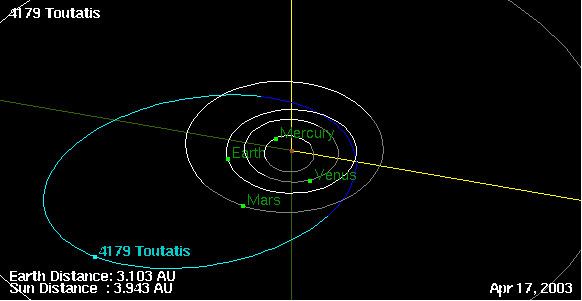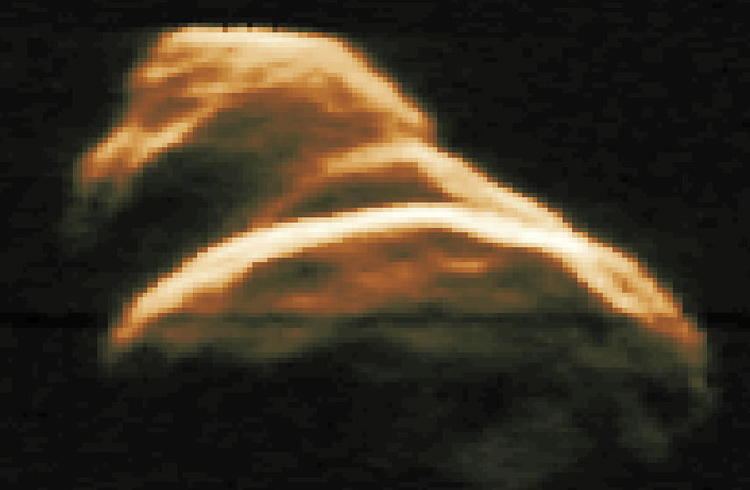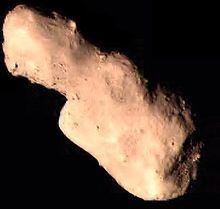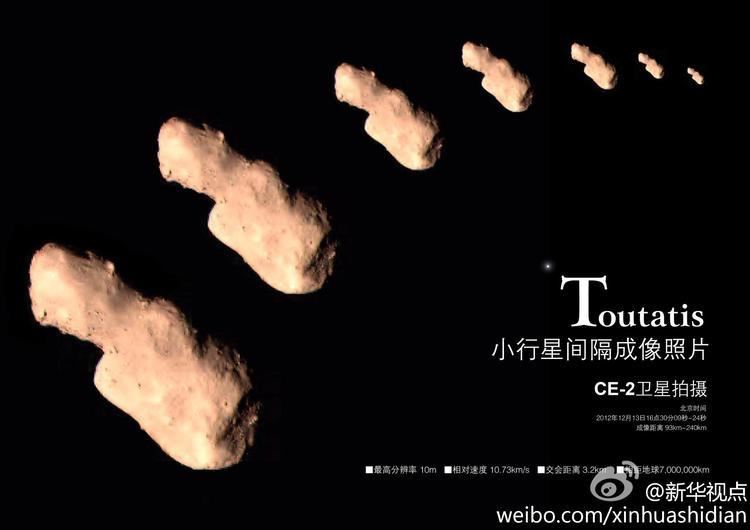Alternative names 1934 CT; 1989 AC Aphelion 4.1296 AU (617.78 Gm) Discovered 4 January 1989 | Discovery date 4 January 1989 Observation arc 29317 days (80.27 yr) Orbital period 1,471 days | |
 | ||
Similar Sun, Solar System, 951 Gaspra, 433 Eros, 99942 Apophis | ||
Asteroid 4179 toutatis up close video
4179 Toutatis (/tuːˈtɑːtᵻs/ too-TAH-tis) is an Apollo, Alinda, and Mars-crosser asteroid with a chaotic orbit produced by a 3:1 resonance with the planet Jupiter, a 1:4 resonance with the planet Earth, and frequent close approaches to the terrestrial planets, including Earth. With its close approaches, and being about 4.6 km across, it is listed as a potentially hazardous object, although the probability of a collision with Earth is minute.
Contents
- Asteroid 4179 toutatis up close video
- Asteroid 4179 toutatis jpl nasa
- Properties
- Orbit
- Close approaches and collision risk
- Physical characteristics
- Giant basin
- Observation
- Exploration
- References

On December 12, 2012 at 06:40 UT Toutatis passed within about 18 lunar distances of Earth. On December 13, the Chinese lunar probe Chang'e 2, launched in 2010 on a lunar mission, flew by Toutatis at a distance of 3.2 kilometers and a relative velocity of 10.73 km/s. Toutatis will approach Earth again in 2016, but will not make another notably close approach until 2069.

Asteroid 4179 toutatis jpl nasa
Properties

4179 Toutatis was first sighted on February 10, 1934, as object 1934 CT, but lost soon afterwards. It remained a lost asteroid for several decades until it was rediscovered on January 4, 1989, by Christian Pollas, and was named after the Celtic god of tribal protection Toutatis (Teutates).

The spectral properties suggest that this is an S-type, or stony asteroid, consisting primarily of silicates. It has a moderate Bond albedo of 0.13. Radar imagery shows that Toutatis is a highly irregular body consisting of two distinct "lobes", with maximum widths of about 4.6 km and 2.4 km respectively. It is hypothesized that Toutatis formed from two originally separate bodies which coalesced at some point, with the resultant asteroid being compared to a "rubble pile".

Its rotation combines two separate periodic motions into a non-periodic result; to someone on the surface of Toutatis, the Sun would seem to rise and set in apparently random locations and at random times at the asteroid's horizon. It has a rotation period around its long axis (Pψ) of 5.38 days. This long axis is precessing with a period (Pφ) of 7.38 days. The asteroid may have lost most of its original angular momentum and entered into this tumbling motion as a result of the YORP effect.
Orbit

With a semimajor axis of 2.5294 AU, or roughly 2.5 times the distance between Earth and the Sun, Toutatis has a 3:1 orbital resonance with Jupiter and a near-1:4 resonance with Earth. It thus completes one orbit around the Sun for every 4.02 annual orbits of Earth. The gravitational perturbations caused by frequent close approaches to the terrestrial planets lead to chaotic behavior in the orbit of Toutatis, making precise long-term predictions of its location progressively inaccurate over time. Estimates in 1993 put the Lyapunov time horizon for predictability at around 50 years, after which the uncertainty region becomes larger with each close approach to a planet. Without the perturbations from the terrestrial planets the Lyapunov time would be close to 10,000 years. The initial observations that showed its chaotic behavior were made by Wiśniewski.
The low inclination (0.47°) of the orbit allows frequent transits, where the inner planets Mercury, Venus, Earth, and Mars can appear to cross the Sun as seen from the perspective of Toutatis. Earth did this in January 2009, July 2012 and July 2016, and will also do so in 2020.
Close approaches and collision risk
Toutatis makes frequent close approaches to Earth, with a currently minimum possible distance (Earth MOID) of just 0.006 AU (2.3 times as far as the Moon). The approach on September 29, 2004, was particularly close, at 0.0104 AU (within 4 lunar distances) from Earth, presenting a good opportunity for observation, with Toutatis having an apparent magnitude of 8.8 at its brightest. A close approach of 0.0502 AU (7,510,000 km; 4,670,000 mi) happened on November 9, 2008. The most recent close approach was on December 12, 2012, at a distance of 0.046 AU (6,900,000 km; 4,300,000 mi), with a magnitude of 10.7. At magnitude 10.7, Toutatis was not visible to the naked eye, but just visible to experienced observers using high-end binoculars. During the 2012 encounter Toutatis was recovered on May 21, 2012, by the Siding Spring Survey at apparent magnitude 18.9. The next notable close approach will be November 5, 2069, at a distance of 0.0198486 AU (2,969,310 km; 1,845,040 mi).
Given that Toutatis makes many close approaches to Earth, such as in 1992, 1996, 2000, 2004, 2008, and 2012, it is listed as a potentially hazardous object. With an uncertainty parameter of 0, the orbit of Toutatis is very well determined for the next few hundred years. The probability of the orbit intersecting Earth is essentially zero for at least the next six centuries. The likelihood of collision in the distant future is considered to be very small. As a planet-crossing asteroid, Toutatis is likely to be ejected from the inner Solar System within a time scale of a few million years or less, giving it a limited number of opportunities to hit Earth. In 2004 a chain e-mail falsely claimed that Toutatis had a 63 percent chance of impacting Earth that year. In fact, Toutatis passed by at 1.5 million kilometres, or about four Earth–Moon distances, as predicted.
In 2006 Toutatis came closer than 2 AU to Jupiter. In the 2100s, it will approach Jupiter many times at a similar distance.
Physical characteristics
Large amounts of data of Toutatis was obtained during Chang'e 2's flyby. Toutatis is not a monolith, but most likely a coalescence of shattered fragments. This bifurcated asteroid is shown to be mainly consisting of a head (small lobe) and a body (large lobe). The two major parts are not round in shape, and their surfaces have a number of large facets. In comparison with radar models, the proximate observations from Chang'e-2's flyby have revealed several remarkable discoveries concerning Toutatis, among which the presence of the giant basin at the big end appears to be one of the most compelling geological features, and the sharply perpendicular silhouette in the neck region that connects the head and body is also quite novel. A large number of boulders and several short linear structures are also apparent on the surface.
Giant basin
The giant basin at the big end of Toutatis has a diameter of ~805 m, suggesting that one or more impactors may have collided with it there. The most significant feature is the ridge around the largest basin. The wall of this basin has a relatively high density of lineaments, some of which seem to be concentric to the basin. These ridges are indicative of an internal structure of small bodies and most of the ridges near the largest basin at the big end are most likely related to the huge stress energy during impact.
Observation
Toutatis has been observed with radar imaging from the Arecibo Observatory and the Goldstone Solar System Radar during the asteroid's prior Earth flybys in 1992, 1996, 2000, 2004, and 2008. It was also observed with radar during the December 2012 flyby and potentially will be during the more distant flyby in 2016. After 2016, Toutatis will not pass close to Earth again until 2069.
Resolution of the radar images is as fine as 3.75 m per pixel, providing data to model Toutatis' shape and spin state.
Exploration
The Chinese lunar probe Chang'e 2 departed from the Sun–Earth L2 point in April 2012 and made a flyby of Toutatis on 13 December 2012, with closest approach being 3.2 kilometers and a relative velocity of 10.73 km/s, when Toutatis was near its closest approach to Earth. It took several pictures of the asteroid, revealing it to be a dusty red/orange color.
